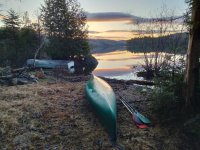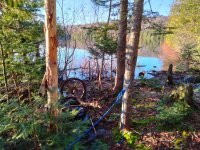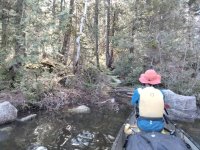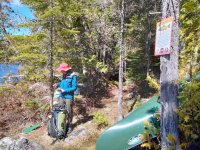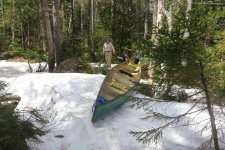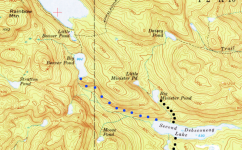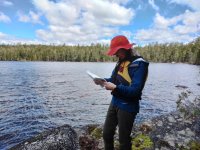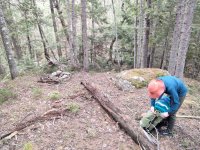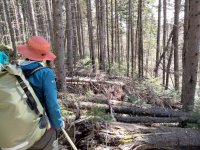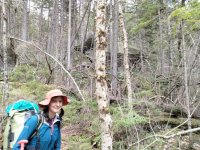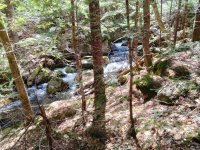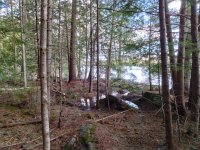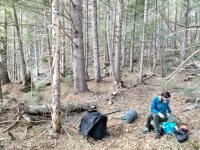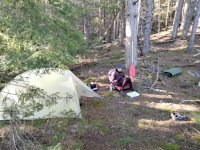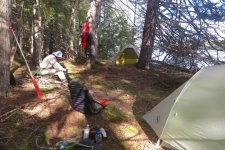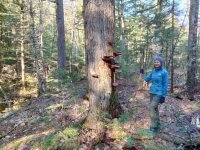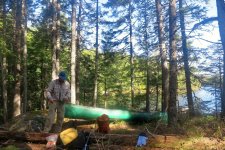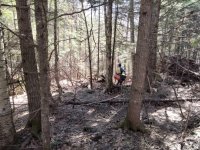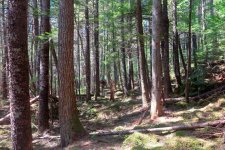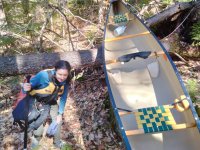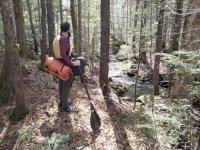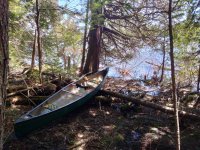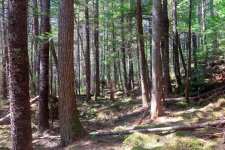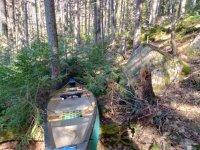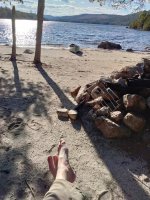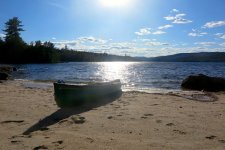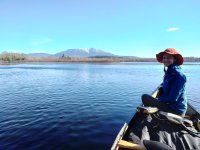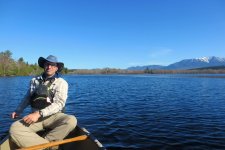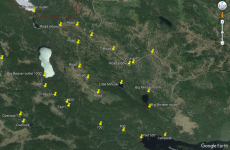Pre-Trip
The Debsconeag Lakes Wilderness Area (The Nature Conservancy) and the state Nahmakanta Unit (Maine Bureau of Parks and Lands) combine for form a ~90,000 acre preserve in the area southwest of Baxter State Park. The "100 mile wilderness" stretch of the AT passes through here. It's a very rocky collection of small to medium sized ponds and moderate height peaks and cliffs. Nothing huge like Katahdin or Chesuncook, but instead just lovely scenery at mezzo scale. I keep wanting to reuse the word "rough" -- there is very little plain old dirt in the area, only rocks, roots, moss and mud. Debsconeag means "Carrying place" in the Abanaki language and indeed the ponds are connected by a number of portage trails. There are roads of course, but for the most part they poke in from the perimeter and none cross the center.
The idea for this trip started with the map. The northwest and southeast parts of the wilderness area are oddly disconnected, the Rainbow Lake area mainly accessed from the north, the Debsconeag area from the east and south. To travel between them on offically mapped routes one has to either go all the way over to Nahmakanta (long portage followed by a whitewater run that dries up in summer), endure an absurd mountaintop portage along the AT to Hurd Pond, or go up to the West Branch and float/portage all the way down to Debsconeag Deadwater. Rainbow Lake and Second Debsconeag Lake are a mere 2.5 miles apart, with the smaller Beaver and Minister ponds even closer, surely there was a route connecting them, back in the day?
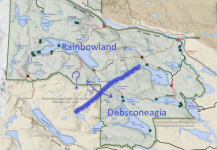
Now where is that jump gate?
Despite some searching, I couldn't find the key trail for such a route on any old maps. In David Cooke's terminology (Above the Gravel Bar), this would have been a "neighborhood route", not an important long distance trail like the Millinocket Carry or the Maliseet Trail, so I suppose the lack of documentation is not all that surprising. Still, it would have been heartening to see a dotted line somewhere. With that in mind, the "Can't Get There from Here Canoe Club" (i.e., Hope and me), set out to find the elusive "wormhole" between Rainbowland and Debsconeagia.
We planned a three night trip starting at the Little Holbrook Pond access in the northwest corner of the preserve, and finishing at the Grant Brook Road bridge near where the West Branch empties into Ambajejus Lake. Nearly all of the route was either "in the book" or known to us from previous visits, so other than the uncertain "wormhole" we were confident it would all prove navigable.
Day Zero (Thursday)
Hope and I met at Katahdin General Store in Millinocket, the last chance to buy wine, cookies or brake fluid before heading into the woods (this time only cookies were required). Work schedules meant that we couldn't start until late Thursday afternoon, so we were hustling to make the best use of daylight. We dropped Hope's car at our planned takeout, the bridge where the Grant Brook Road crosses the West Branch of the Penobscot, and headed further west to our starting point, the Little Holbrook Pond access. The road to the latter is a bit sketchy, and recent rains had made a few large puddles, but I managed to avoid beaching my Subaru and we were unloading at about 6pm. It was raining lightly, but we weren't too fussed about that since the forecast for the rest of the weekend was dry.
It was a couple hundred yards from the parking area to the put-in on the pond, but we won't count that as a portage. (I like when land managers buffer the access, a parking lot at the water's edge is unnecessary and detracts from both water quality and scenic beauty. Also, the last 100 yards is usually muddy anyway.) Our planned route had 6-8 portages total, including a long one that would presumably be pure bushwhacking, so we both packed fairly light. We were on the water at about 6:30pm. We didn't dillydally around as we knew there weren't any good campsites on Little Holbrook or Holbrook, and thus wanted to get to Rainbow before dark.
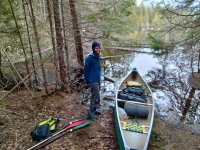
Rain gear required, but good to be getting out there
We were using my Penobscot 16, with seats and thwarts pretty much stock.
The carry from Little Holbrook to Holbrook is just a hundred yards. There are a bunch of cached boats at the south end, which is curious. Would someone carry a canoe 200 yards from their vehicle to the put-in, paddle 0.5mi across Little Holbrook, walk 100 yards and then launch a different boat on Holbrook? Maybe those are lucky fishing boats on that pond only? IDK.
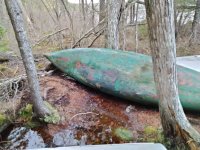
Lucky fishing canoe?
Some art gallery should do an exhibit of cached canoes. This one had stories to tell, I'm sure, all rendered in degenerating fiberglass.
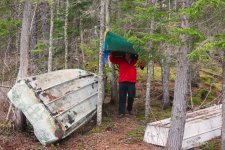
Parking for Sears brand jonboats only?
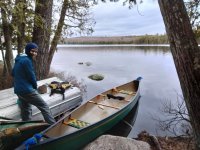
Arriving at the south end of Holbrook Pond, we took out at yet another cache of boats and located the portage trail leading to Rainbow. The trail isn't on any recent maps, but I knew from a previous visit that it was in decent shape. It is shown on the 1950's topo, but the route has changed slightly. I believe the Rainbow Lake Lodge staff maintain it so they can bring people on day trips to Holbrook.
We didn't take any more pictures since it was getting dark and we were in a hurry. Although we'd packed light, with a ~60# royalex boat and rough trails we weren't attempting any single carries, so we had to walk the ~0.6mi trail three times. The first hike over with the packs went fine, we had to search for the trail in places but we always eventually found a red blaze. Returning unladen we were practically jogging as the light was fading. For the third pass Hope was carrying our small drybags, PFDs and one paddle; I was just carrying the canoe. Fortunately one of those drybags had a headlamp or we'd have been screwed. Hope led the way, and I angled in the general direction of the light while trying not to trip.
Given that this was ostensibly a bushwhack portage trip in search of a lost route, I really shouldn't have complained about portaging on a trail, but I sure did complain. The modern routing of the trail was fine for nimble foot traffic but was a huge pain for a canoe. Often it would squeeze between a tree and a boulder in such a way that one couldn't get through while balancing the canoe -- there was room overhead, but it was above the boulder not above the trail. A proper portage trail may muddy your boots but it doesn't require any sharp turns or odd yoga poses.
It was fully dark when we finally arrived at the put-in on Rainbow Lake (more cached boats), relieved to have only a short paddle ahead of us that evening. Paddling in the dark is way easier than hiking in the dark. We got out a second headlamp and commenced loading up.
We had a bit of a scare when we couldn't find my PFD -- was it back at Holbrook? -- but it turned out to be just a few yards back on the trail. Once on the water, we followed the shore to the west looking for a campsite. The official map showed two in the northwest cove, and before long we found one, easily visible as a clearing at the water's edge with (what else) a cached boat. The rain had eased up, so we quickly made camp and warmed up some food.
(to be continued)

